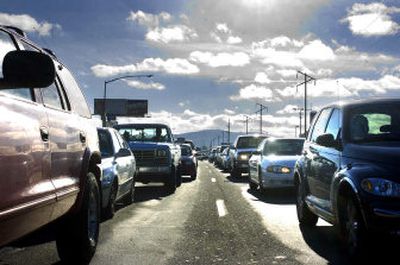Sullivan Road traffic jammed

Commerce is bustling along Sullivan Road in Spokane Valley and so is the traffic.
Christmas shoppers and employees pour in and out of 23 restaurants, five banks, two hotels and more than 70 other storefronts between Sprague and Interstate 90.
To the north, the Valley Mall and the industrial park add even more drivers to Sullivan, which holds the highest daily traffic count in the city along its busiest stretch at the freeway.
“It’s getting worse and worse all the time,” said Kathy Carson-Krey during a recent trip to Fred Meyer.
The wait to leave the card shop where she works at the same strip mall topped out at seven minutes recently, she said.
“With all this growth you’re just seeing a lot more jam-ups,” said Tom Ratkovich, the manager at Golf Universe in the same complex.
There was a five-car wreck near his store the week earlier, and he said he regularly watches people from the parking lot get themselves into dangerous situations trying to beat traffic as they leave or enter the lot.
While seasonal shopping is at the root of much of the congestion this time of year, Spokane Valley’s growing population and developments outside the city spell an uncertain future for the road that already carries 10,700 to 40,000 vehicles on average every day.
The new freeway interchange at Evergreen provides shoppers another access to the mall and has taken some pressure off. Traffic counts on Sullivan south of Broadway have declined slightly since 2004. But counts north of the freeway and near the Sullivan interchange have increased and will climb dramatically in next few years as Spokane County finishes improvements to Bigelow Gulch Road.
The route has long been used as a shortcut between Spokane Valley and Spokane’s north side and draws much of its traffic from I-90 at Sullivan.
“That’s where the traffic demand is. People want to go to the Sullivan Road and Sullivan Road Interchange,” said then-County Engineer Ross Kelley at a public hearing March 22.
“We have ways of doing traffic analysis to determine where people want to go and where they’re coming from. And that’s a very strong demand that’s coming from the Sullivan Road, I-90 area to the north side,” he said, responding to a suggestion that Bigelow Gulch be connected to Barker or Flora instead.
Estimates of the project’s traffic impacts on Sullivan, though, don’t go any farther south than Wellesley where the county predicts 19,000 vehicles will pass every day in 2025.
The environmental assessment process is not complete, and county engineers say the county is working on a supplement to the study to address questions from the Federal Highway Administration.
The first draft of the environmental study, though, doesn’t forecast the impact to Sullivan at Trent or at I-90.
“What concerns me is they are throwing the ball in our court, and of course it’s going to be our monies and everything else that take care of it,” said Spokane Valley Councilman Gary Schimmels.
Spokane Valley will be responsible for upgrading most of the roads and bridges inside the city limits to accommodate the project.
When traffic gets busy, the windows of Schimmels’ key shop look out on the cars backed up at the intersection of Sullivan and Sprague. At peak hours, cars in the eastbound lanes regularly have to wait more than one cycle at the light to get through.
Funding questions aside, the city is limited in what it can do to fix it. Engineers have looked at removing some of the concrete barriers to allow more people to line up for left turns, but space is limited to make the intersection any bigger.
Congestion at Sprague, Barker and Sullivan is expected to increase, not just from Spokane Valley’s growing population but also from new housing outside of town.
Last year county commissioners settled an appeal by property owners who wanted their land within the urban growth area but had been denied by a previous board of commissioners. Land now permitted to be developed is expected to result in close to 1,000 new houses just southeast of the city.
City Council members were so frustrated that the city wasn’t consulted about the impact the housing would have on city streets that it threatened to take the county to court if it didn’t begin joint planning.
The future of development north of the city is also unclear. The Bigelow Gulch environmental study assumes development patterns will stay the same, even though large road improvements historically drive up pressure to develop the land around them.
Already one landowner north of Spokane Valley has cited the added traffic capacity from the project as a reason his land should be eligible for urban development.